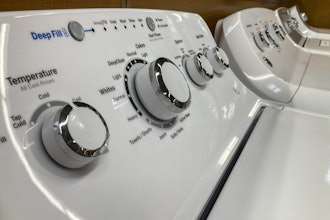A functional definition of pH is the measurement of the acidity or alkalinity of a solution commonly measured on a scale of 0 to 14. pH 7 is considered neutral, with lower pH values being acidic and higher values being alkaline or caustic. pH is the most common of all analytical measurements in industrial processing and since it is a direct measure of acid content [H+], it clearly plays an important role in food processing. Among the reasons for measuring pH in food processing include:
•To produce products with consistent well defined properties
•To efficiently produce products at optimal cost
•To avoid causing health problems to consumers
•To meet regulatory requirements
Fig. 1: pH of various foods
(click image for larger version)
The pH range of foods varies considerably with some typical values of food and related solutions illustrated in Figure 1. Due to the logarithmic nature of the measurement, even small changes in pH are significant. The difference between pH 6 and pH 5 represents a ten-fold increase in acid concentration; a change of just 0.3 represents a doubling of acid concentration. Variations of pH can impact flavor, consistency, and shelf-life.
Measuring pH
Fig. 2: Examples of various pH sensors; 2A, Glass Sensor; 2B, ISFET Non-glass Sensor; 2C, Puncture Sensor
Fig. 3: Relationship of pH, sugar content and gel (click image for larger version)
The most common method for pH measurement uses a pH electrode. These sensors act as a small battery, generating a voltage signal proportional to the solution pH. Manufacturers of pH measurement equipment offer hundreds of styles of pH electrodes to meet the demands of the thousands of unique application challenges. Three styles shown in Figure 2 are the conventional glass electrode, ISFET non-glass electrode, and a unique “puncture” electrode.
It is common in the food industry to make pH measurements by taking a grab-sample from the process, and bringing it to a central lab for analysis. For dynamic processes, the time delay in getting the lab result is less than ideal for process control. Optimal control is obtained by in-line pH analysis. Today, use of non-glass pH electrodes, Figure 2B, eliminates any concern about glass breakage and allows for continuous pH measurement, directly in the process line.
One example of pH control requirements is in the manufacture of fruit jelly. The gel formation brought about by pectin takes place over a narrow pH range, which is further complicated by sugar concentration. As shown in Figure 3, too high a pH value results in an unacceptable liquid. Too low pH causes the mixture to gel prematurely, resulting in an overly hard product. Continuous pH adjustment using edible acids such as citric acid yields the optimal gel consistency.
pH plays a critical role throughout the processing stages in the food industry. In the dairy industry for example, incoming raw milk is first checked to assure freshness. During butter production, bacteria cultures convert lactose (milk sugar) to lactic acid, dropping the pH from 6.6 to 4.8. Careful monitoring and temperature control is required to slow down bacteria activity to prevent over acidification. In the making of cheese, the enzymes used are particularly sensitive to pH with variations of ± 0.1 pH impacting reaction activity by as much as 50 percent. Finally, the cheese ageing process can be accurately monitored using the puncture probe. In addition to the specific dairy product processes, facility water purification, plant utility water and wastewater, all require pH control for proper operation.
Not all pH measurements are made in liquids. A unique application uses a “puncture” electrode specifically designed for measurements in semi-solid foods (Figure 2C). Fresh meat quality will deteriorate rapidly if proper storage conditions are not maintained. pH is a valuable rapid parameter to monitor meat quality to prevent or detect quality deterioration. Monitoring the aging of cheese or sausage can also be determined with a simple jab. Product storage temperature can then be controlled to optimize the ageing process.
Sources of Variation
Accurate ingredient blending ratio control is often not adequate to assure correct results. One reason pH needs to be monitored is due to variations in the raw ingredients. Whether products originate growing in the fields, grazing the plains, or swimming the oceans, specific growing conditions have subtle but significant variations in the incoming raw ingredients. Weather, geography, climate, soil, and degree of cultivation all play a role. Batch-to-batch or seasonal variation may be further compounded by inter-reactions between other blended ingredients.
Fig. 4: Product Yield vs. pH
(click image for larger version)
Also, some food processes utilize living organisms, such as in cheese and yogurt ripening, live yeast to for bread products, or fermentation of beer and wine. The complex reactions that take place are heavily impacted by the pH of the process medium. Biological processes have an ideal pH value yielding the optimum product yield and/or quality [Figure 4]. Operation either above or below the target value can have a direct negative impact on operating costs.
Clean-in-place (CIP) systems typically use a caustic cleaning solution to disinfect process piping. Conductivity is an ideal measurement parameter to control CIP chemical concentration for proper cleaning effectiveness. One weakness is that conductivity is non-specific, unable to distinguish between a solution of sodium hydroxide from phosphoric acid. Whenever multiple cleaning agents are used, the combination of pH with conductivity provides an unbeatable team of linear conductivity response with the specific ability of pH to confirm the identity of the solution in the pipe line.
The use of CIP solutions introduces the possibility of inadvertent seepage of the cleaning agent into the food product. To assure both consumer safety and product quality, beverages in particular use a final pH measurement at the bottling machine to confirm that the product is safe for consumption.
pH plays an important role in food processing whether the objective is to make sour bread not too sour, cheese with a bite, or beer that is just right. Constant pH measurement and controlled addition of buffering agents compensates for intangible process variations and assures reliable product quality.


















